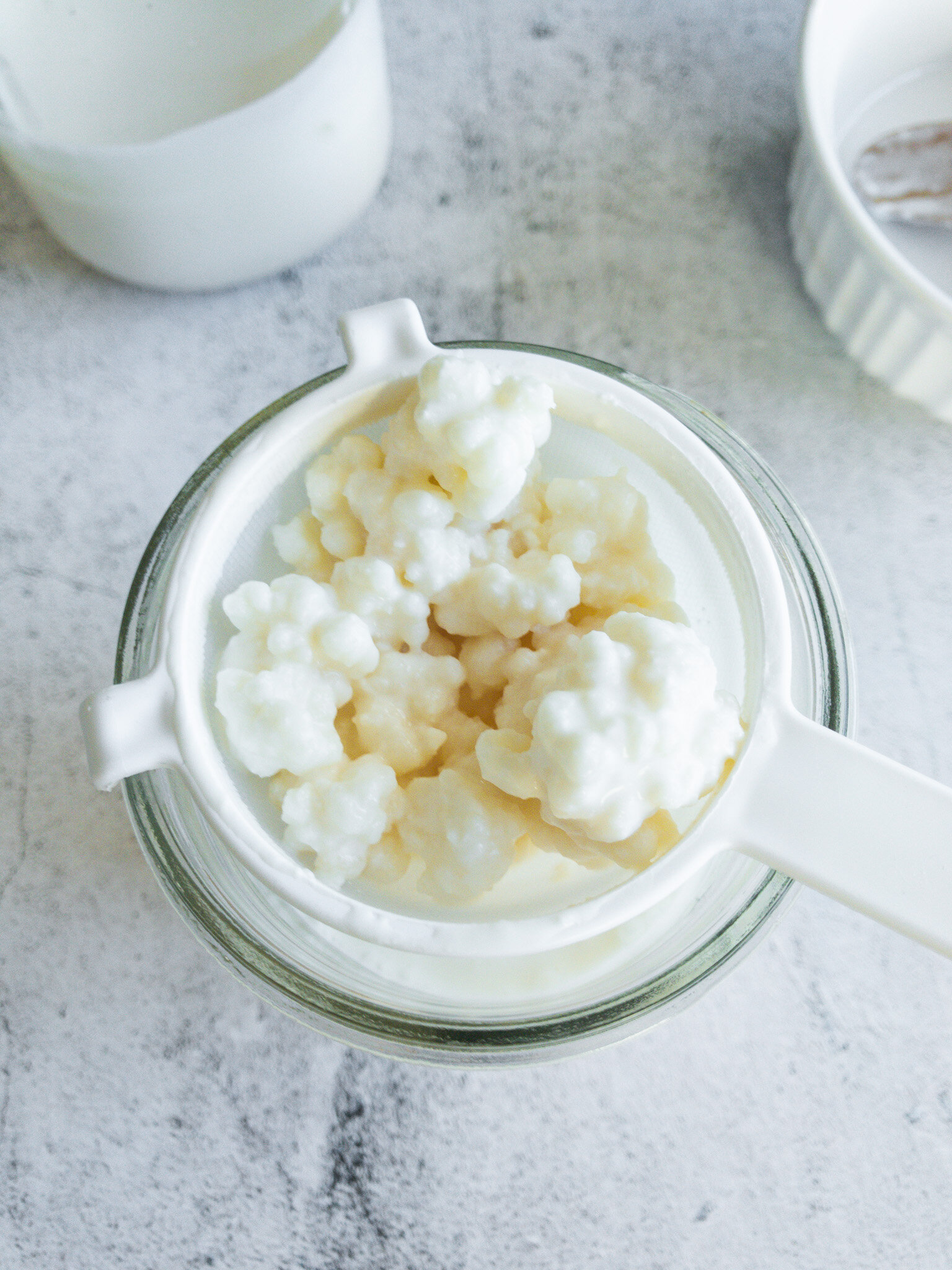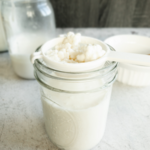Homemade Raw Milk Kefir
What is Milk Kefir?
It is a probiotic drink, like liquid yogurt, that contains thousands of beneficial bacteria and yeasts. It helps to control the overgrowth of yeast or candida your body might be fighting. It has been used traditionally for centuries to prolong the shelf life of milk and to heal from infections, fungal infections, and low immune function.
It’s especially beneficial if you have:
sugar cravings
rashes
acne
joint pain
digestive issues
sinus infections
Milk kefir is made from kefir grains, which are living organisms of probiotics and yeasts trapped by a complex matrix of polysaccharides and proteins.
The Benefits of Milk Kefir
Nutrient-dense food
Milk kefir is an especially nutrient-dense food because it is made from one of the most nutrient-dense whole foods known to humans. Milk is known to contain fat-soluble vitamins such as D, A, E, and K. It also contains vital nutrients such as vitamin C, B12, and B6. There are abundant essential minerals such as calcium, magnesium, and phosphorus that are found in milk kefir which support the body’s immune system, cell function, and metabolism.
Supports a healthy digestive system
The live probiotics and prebiotics of milk kefir help to repopulate the microbiome with beneficial microbes. Milk kefir has shown to improve constipation, diarrhea, gas, and bloating.
Antibacterial, anti-fungal, and anti-neoplastic properties
Kefir is a traditional food that has been used to help with infection and dis-ease symptoms. This study provides proof that kefir and kefir grains contain antibacterial, anti-fungal, and tumor destroying properties.
Kefir grains are anti-inflammatory
This research article results show the findings of anti-inflammatory prebiotic compounds present in symbiotic cultures of kefir growing in both aqueous and milky suspensions.
Calms nervous system
The B vitamins and other nutrients like Tryptophan in milk help to calm the nervous system. When we have stress, our bodies use up these nutrients quickly so we need to emphasize replenishment. Research has also shown that kefir contains a specific carbohydrate that has been associated with lowering blood pressure and cholesterol.
Strengthens the immune system
One incredible study showed that the immuno-modulating effects of kefir were strong even when it was diluted! For example, it showed that diluted kefir modulated the mucosal immune system by activating the Th1 and Th2 immune responses.
Milk Kefir on GAPS
The GAPS nutrition protocol recommends introducing kefir after yogurt because there can sometimes be a very strong die-off reaction from the pathogenic bacteria that kefir replaces in your gut. However, kefir can be especially necessary for pathogenic yeasts such as candida albicans, because the beneficial yeasts crowd out the overgrowth pathogenic yeasts.
GAPS kefir is also fermented for a full 24 hours to help reduce the amount of lactose in the final cultured drink. This is especially beneficial for individuals who have pathogenic bacteria, which tend to feast on lactose and create symptoms of gas, bloating, constipation, and diarrhea.
Why you Should Make Kefir Yourself
Making your own milk kefir is an essential part of GAPS or other gut healing protocols. The benefits of this superfood can be what make or break your healing progress. Store-bought milk kefir is often fermented for a shorter period of time and sometimes doesn’t even contain live probiotics. The milk used is pasteurized and sometimes homogenized which disrupts the digestive process. You might still get some benefits from store-bought milk kefir, however, you will experience much more if you make it yourself.
If you can’t get your hands on raw milk, you can use a good quality organic, grass-fed, low-heat pasteurized store-bought milk and revive the nutritional value by fermenting the kefir yourself.
Tips for Homemade Milk Kefir
You can purchase dehydrated kefir grains on Etsy or on Cultures for Health’s website. I found mine through a local Weston A. Price Foundation Chapter member.
Kefir grains should never have contact with metal.
Kefir cultures at different speeds depending on the temperature. You might have to give the kefir more attention in the summertime as opposed to the winter months.
Kefir is very forgiving. It’s kind of like a Giga Pet! You have to feed it daily, give it some movement (a little swirl), and then it will grow!
Homemade Raw Milk Kefir
GAPS (Gut and Psychology Syndrome), Weston A. Price
Natalie Earle | Feb 2021
- prep time: 5-10 min
- ferment time: 12-24 hours
Ingredients:
- 2-4 Tbsp of live kefir grains
- 1-2 cups of raw milk (or quality low-heat pasturized milk)
- Quart size glass jar (sterilized with hot water)
- wooden spoon
- non-metal fine strainer
Instructions:
- Place the kefir grains in a jar and cover with raw milk. It's important that the ratio of grains to milk bo about 1:7 (flexible).
- Place a lid on the jar and leave on the counter at room temperature (best between 65-72 degrees F) for 12-24 hours. 24 hours is a true GAPS ferment. Gently shake the jar occasionally to redistribute the grains in the milk.
- The milk will get very tart the longer you ferment and it will eventually start to separate and curdle. This kefir is fine to drink or you can strain with cheese cloth to make a kind of cream cheese.
- When the kefir is done to your liking, strain the grains from the cultured milk.
- Place the grains in another clean jar and repeat the steps to start a new batch immediately.
- Or, you can place the grains in a jar with milk and store in the refrigerator for up to 2 weeks (add plenty of milk if you plan to leave for that long).
Notes:
- Kefir will last for weeks in the refrigerator as it will slowly continue to culture.
- As you culture more and more batches, your kefir grains will continue to grow. You can separate them to make sure the ratio of milk to grains will yield the amount of kefir you would like to make and drink!






